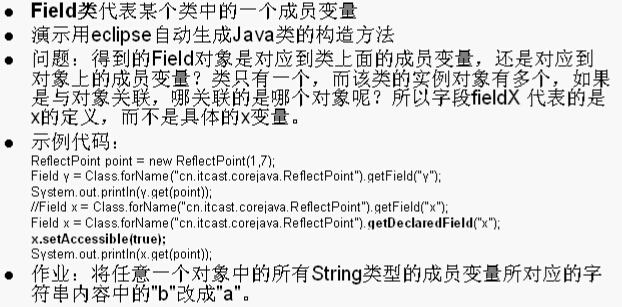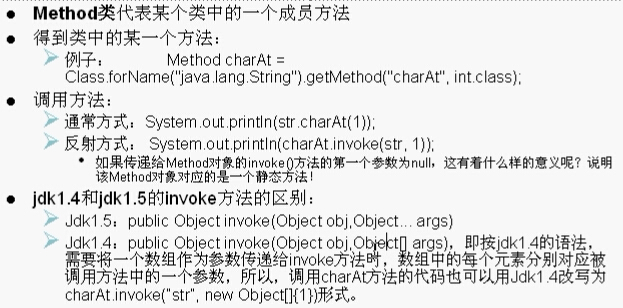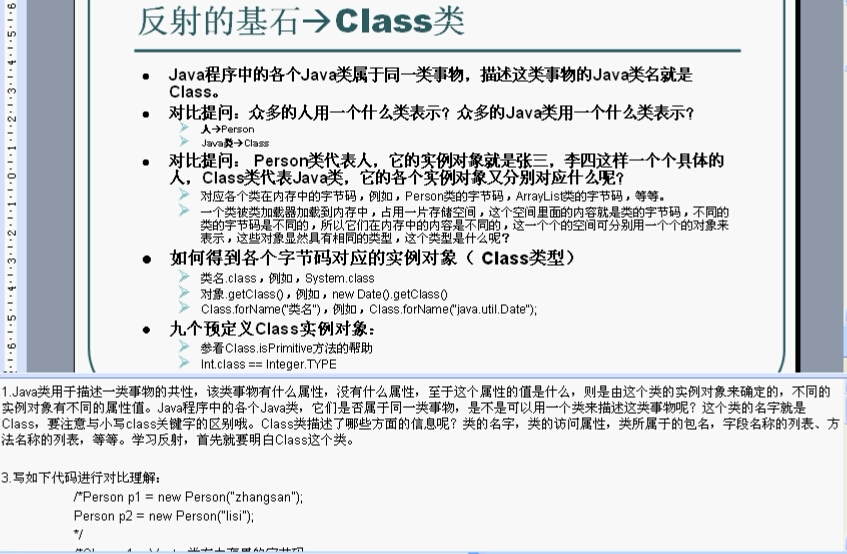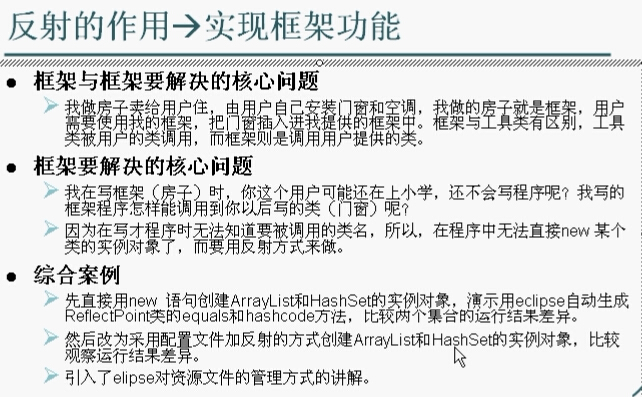补充:数组类型的Class实例对象
class.isArray()
总之,只要是在源程序中出现的类型,都有各自的Class实例对象,例如,int[],void。。。
class ReflectTest
{
public static void main(String[] args) throws Exception
{
String str1="abc";
Class cls1 = Str1.getClass();
Class cls2 = String.class;
Class cls3 = Class.forName("java.lang.String");
System.out.println(cls1==cls2);//true
System.out.println(cls2==cls3);//true
System.out.println(cls1.isPrimitive());//false
System.out.println(int.class.isPrimitive());//true
System.out.println(int.class == Integer.class);//false
System.out.println(int.class == Integer.TYPE);//true.TYPE所包装的基本类型的字节码。
System.out.println(int[].class.isPrimitive());//false
System.out.println(int[].class.isArray());//true
}
}
Constructor类

Field类

method类

用反射方法执行某个类中的main方法
为什么要用反射的方式调用?

注意:
<span style="font-size:10px;">class ReflectTest
{
public static void main(String[] args) throws Exception
{
String str1="abc";
Class cls1 = Str1.getClass();
Class cls2 = String.class;
Class cls3 = Class.forName("java.lang.String");
System.out.println(cls1==cls2);//true
System.out.println(cls2==cls3);//true
System.out.println(cls1.isPrimitive());//false
System.out.println(int.class.isPrimitive());//true
System.out.println(int.class == Integer.class);//false
System.out.println(int.class == Integer.TYPE);//true.TYPE所包装的基本类型的字节码。
System.out.println(int[].class.isPrimitive());//false
System.out.println(int[].class.isArray());//true
//new String(new StringBuffer("abc"));
Constructor constructor1 = String.class.getConstructor(StringBuffer.class);
String str2 = (String)constructor1.newInstance(/*"abc"*/new StringBuffer("abc"));
System.out.println(str2.charAt(2)); //c
ReflectPoint pt1 = new ReflectPoint(3,5);
Field fieldY = pt1.getClass().getField("y");
//fieldY的值是多少?是5,错!fieldY不是对象身上的变量,而是类上,要用它去取某个对象上对应的值,
System.out.println(fieldY.get(pt1));//5
Field fieldX = pt1.getClass().getFiedl("x");
fieldX.setAccessible(true);//暴力反射
System.out.println(fieldX.get(pt1));//3
changeStringValue(pt1);
System.out.rintln(pt1);
//str1.charAt(1);
//ciecle.draw();
Method methodCharAt = String.class.getMethod("charAt",int.class);
System.out.println(methodCharAt.invoke(str1,1));//(null,1)静态方法不需要对象。
System.out.println(methodCharAt.invoke(str1,new Object[](2)));//按1.4的语法调用
//TestArguments.main(new String[]("111","222","333"));
String startingClassName = args[0];
Method mainMethod = Class.forName(startingClassName).getMethod("main",.class);
//mainMethod.invoke(null,new String[]("111","222","333"));
mainMethod.invoke(null,(Object)new String[]("111","222","333"));
int[] a1 = new int[]{1,2,3};
int[] a2 = new int[4];
int[][] a3 = new int[2][3];
String[] a4 = new String[]{"a""b""c"};
System.out.println(a1.getClass() == a2.getClass());//true
System.out.println(a1.getClass()==a4.getClass());//false
System.out.println(a1.getClass()==a3.getClass());//false
System.out.println(a1.getClass().getName());//[I
System.out.println(a1.getClass().getSuperclass().getName());
System.out.printlna4.getClass().getSuperclass().getName());
Object aObj1 = a1;
Object aObj2 = a4;
//Object[] aObj3 = a1;不可以,int不是Object基本类型
Object[] aObj4 = a3;
Object[] aObj5 = a4;
System.out.println(a1);//[I@...
System.out.println(a4);//[Ljava.lang.String;@...
System.out.println(Arrays.asList(a1));//[[I@....]
System.out.println(Arrays.asList(a4));//[a,b,c]
printObject(a4);
printObjcet("xyz");
}
private static void printObjcet(Object obj)
{
Class clazz = obj.getClass();
if(clazz.isArray())
{
int len = Array.getLength(obj);
for(int i=0;i<len;i++)
{
System.out.println(Array.get(obj,i));
}
}
else
System.out.println(obj);
}
private static void changeStringValue(Object obj) throws Exception
{
Field[] fields = obj.getClass().getFields();
for(Fiedl field : fields)
{
//if(field.getType().equals(String.class))
if(field.getType() == String.class)//同一份字节码用双等号。
{
String oldValue =(String)field.get(obj);
String newValue = oldValue.replace('b','a');
field.set(obj,newValue);
}
}
}
}
class TestArguments
{
public static void main(String[] args)
{
for(String arg : args)
{
System.out.println(arg);
}
}
}</span>class ReflectPoint
{
private int x;
public int y;
public String str1 = "ball";
public String str2 = "basketball";
public String str2 = "itcast";
public ReflectPoint(int x,int y)
{
super();
this.x = x;
this.y = y;
}
public String toString()
{
return str1 + ":" + str2 + ":" + str3;
}
public int hashCode()
{
final int prime = 31;
int resule = 1;
result = prime * result + x;
result = prime * result + y;
return result;
}
public boolean equals(Object obj)
{
if(this == obj)
return true;
if(obj == null)
return false;
if(getClass() != obj.getClass())
retrun false;
final ReflectPoint other = (ReflectPoint) Obj;
if(x != other.x)
return false;
}
}
数组的反射

思考题:int[ ] a = new int[3];
Object[ ] a = new Object[ ]("a",1);
a[0].getClass().getName();
import java.util.ArrayList;
import java.util.Collection;
import java.util.HashSet;
class ReflectTest2
{
public static void main(String[] args) throws Exception
{
InputStream ips = new FileInputStream("config.properties");
Properties props = new Properties();
props.load(ips);
ips.close();//把windows里的关掉,释放资源,减少内存泄露,不是把java里的关掉
String className = prop.getProperty("className");
Collection collections = (Collection)Class.forName(className).newInstance;
Collection collections = new ArrayList();//打印结果是4,
//Collection collections = new HashSet();//打印结果是3,
ReflectPoint pt1 = new ReflectPoint(3,3);
ReflectPoint pt2 = new ReflectPoint(5,5);
ReflectPoint pt3 = new ReflectPoint(3,3);
collections.add(pt1);
collections.add(pt2);
collections.add(pt3);
collections.add(pt1);
//pt1.y = 7;
//collections.remove(pt1);//内存泄露
System.out.println(collections.size());
}
}

























 230
230

 被折叠的 条评论
为什么被折叠?
被折叠的 条评论
为什么被折叠?








